Encrypted-Search browser hijacker (spam) - Free Instructions
Encrypted-Search browser hijacker Removal Guide
What is Encrypted-Search browser hijacker?
Encrypted-Search browser hijacker is the search engine application that controls online traffic without your permission
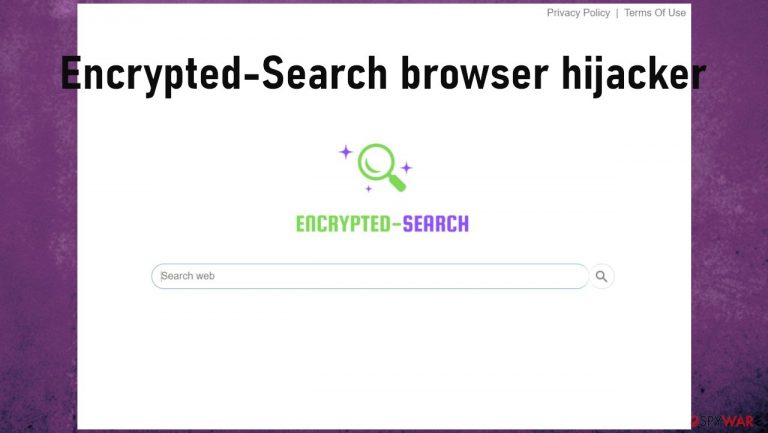
Encrypted-Search is the application that redirects online searches through the additional engines to expose the user to other unwanted material online and even leads to downloads of add-ons, unwanted browser extensions. This is the browser hijacker that is mainly controlled by the PUA that runs in the background. This browser-based application is causing various issues with the time online because of particular browser manipulation.
These intruders spread around using bundling methods that allow to incorporate unwanted apps into packages with freeware downloaded from the web. These applications affect Google Chrome, Internet Explorer, Mozilla Firefox, Safari, and other browsers. Those changed settings can keep the user from accessing wanted and common material online.
Encrypted-Search hijacker appears, triggering redirects and commercial content delivery after the shady installation of other programs. This might be the first symptom, but there are many additional issues related to the PUP installation. The infection is not considered malicious, but users complain about the persistent and annoying threat.
Details about the browser-based application that frustrated users
| Name | Encrypted-Search browser extension |
|---|---|
| Type | Browser hijacker, redirect |
| Category | Potentially unwanted program |
| Issues | The program creates speed problems and manipulates browsers, alters settings like homepage, new tab, search engine preferences |
| URL | Encrypted-Search.com |
| Distribution | Freeware installations result in PUA downloads without your knowledge |
| Damage | These applications continuously redirects and controls the online traffic, so people do not access the content that they want |
| Danger | Exposure to questionable online content leads to installation of other malicious programs |
| Removal | Try to run the anti-malware tool to get rid of the application properly |
| System fix | Running FortectIntego can help with virus damage |
Encrypted-Search browser hijacker is the extension that penetrates the computer system and affects the behavior of the machine. The slowness might occur before those alterations on the browser, so you should immediately react when the machine is not acting normal. These are common indicators that PUP is running on the system:
- altered homepage, new tab, search engine preferences;
- added programs or browser-based apps;
- speed issues;
- redirects to other sites;
- pop-up ads;
- banners and links appearing in random places.
You need to pay attention to any changes because a slight issue with the speed and browsers' settings can be an early sign of a serious infection. Even though the program is not malicious, you cannot be sure that content that you get exposed to is not related to threat actors or dangerous activities.[1] The Encrypted-Search browser extension can trigger redirects to dangerous pages, so you need to get rid of it.
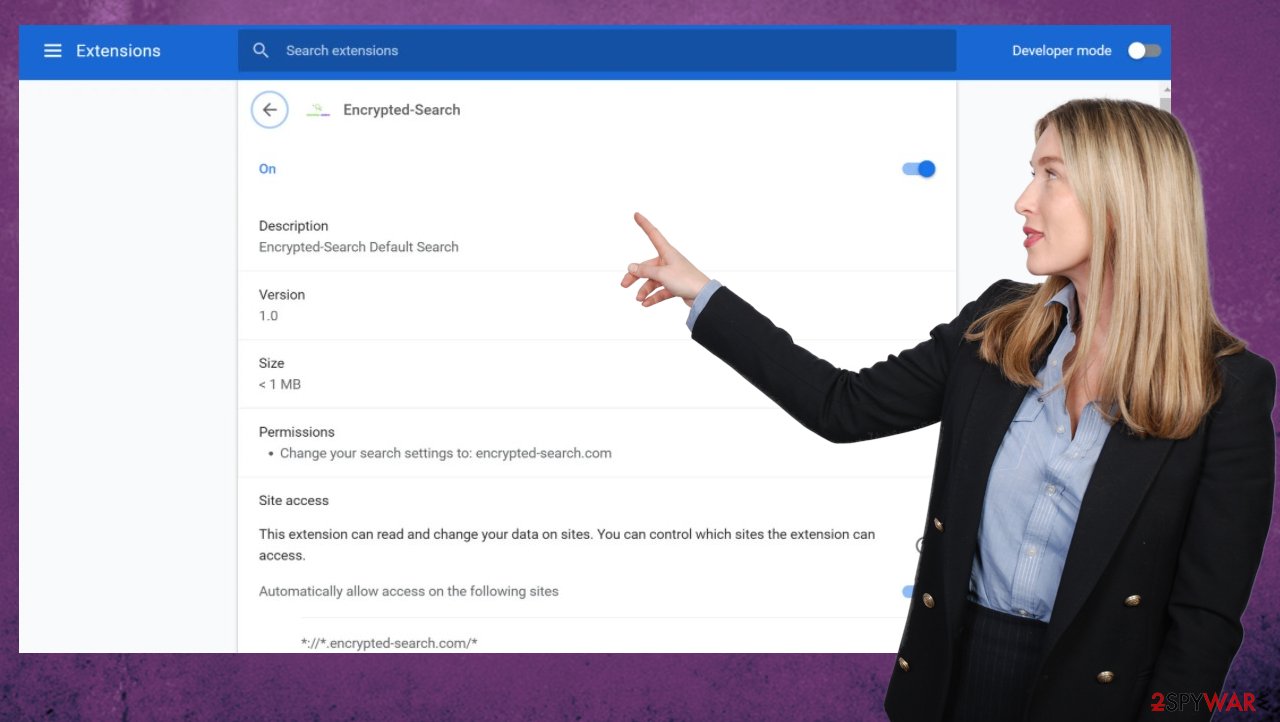
Eliminating the unwanted app and stopping the issues
You might experience problems with the machine and with additional processes besides the online traffic. The program runs in the background and silently alters preferences, even damaging files like DLLs.[2] The program is causing these changes to be persistent. The sooner you get rid of it the sooner those redirects stop.
Running the antivirus application or security tool like SpyHunter 5Combo Cleaner, Malwarebytes can significantly help and improve the process of clearing out the machine. Trigger the removal process and make sure to delete any indicated programs from the list. But then you also need to take care of the issues created by the threat. Alter those preferences that the Encrypted-Search PUP managed to affect manually. The threat mainly affects Chrome, but you cal find tips for other applications below the article.
Delete malicious extensions from Google Chrome:
- Open Google Chrome, click on the Menu (three vertical dots at the top-right corner) and select More tools > Extensions.
- In the newly opened window, you will see all the installed extensions. Uninstall all the suspicious plugins that might be related to the unwanted program by clicking Remove.
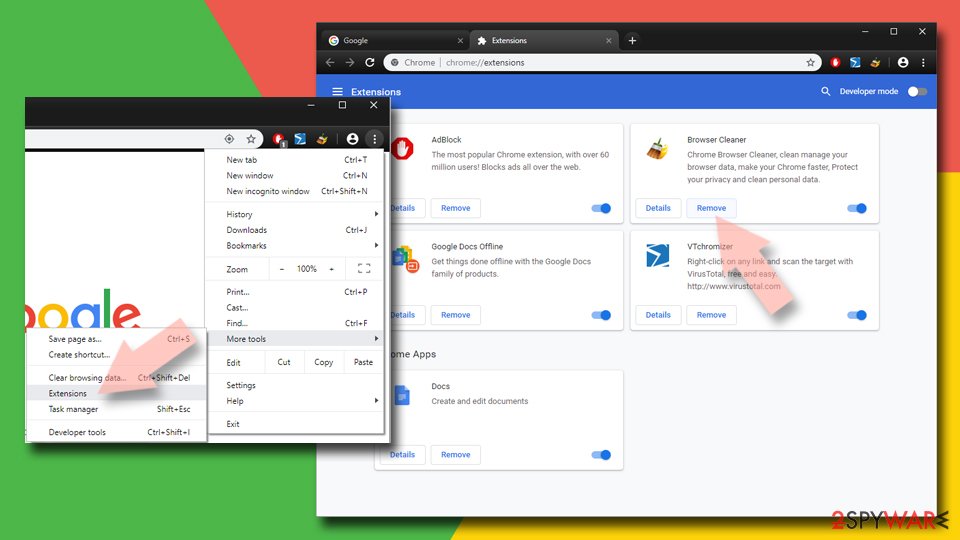
Clear cache and web data from Chrome:
- Click on Menu and pick Settings.
- Under Privacy and security, select Clear browsing data.
- Select Browsing history, Cookies and other site data, as well as Cached images and files.
- Click Clear data.
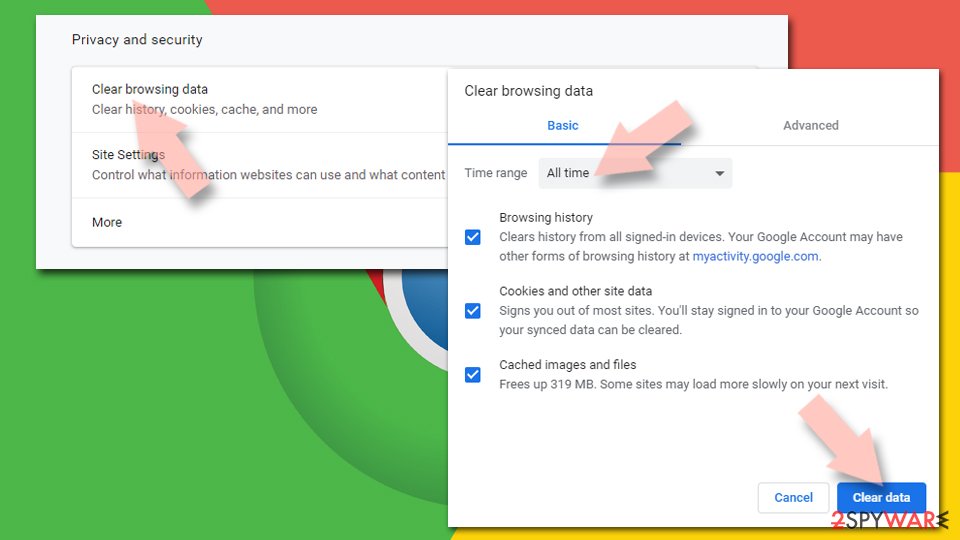
Change your homepage:
- Click menu and choose Settings.
- Look for a suspicious site in the On startup section.
- Click on Open a specific or set of pages and click on three dots to find the Remove option.
Reset Google Chrome:
If the previous methods did not help you, reset Google Chrome to eliminate all the unwanted components:
- Click on Menu and select Settings.
- In the Settings, scroll down and click Advanced.
- Scroll down and locate Reset and clean up section.
- Now click Restore settings to their original defaults.
- Confirm with Reset settings.
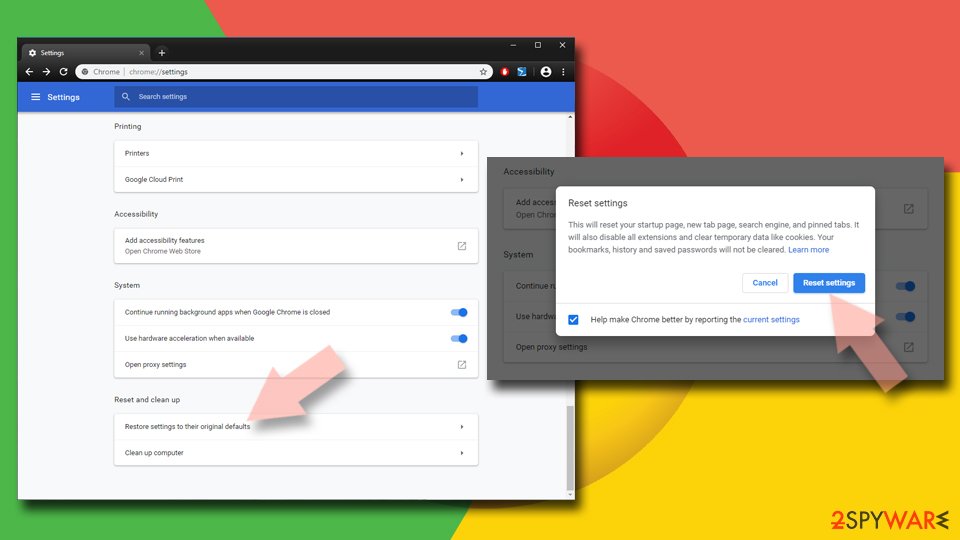
Encrypted-Search browser plugin that is not installed by yourself can be hidden and act up in the background. If you recently downloaded a program from the internet, torrent site, pirating platform or you often stream tv shows, movies online – this activity might be the cause of PUP infection.
These problems with silent infections are often addressed by experts[3] because PUPs can cause major issues with privacy, data tracking, exposure to dangerous sites and commercial pages. These programs also can come from promotional ads, and users might install the toolbar or extension by falling for the claims about the useful features of the Encrypted-Search hijacker.
Try to stay away from these insecure tools and make sure to use only reliable sources for the downloads of freeware. Choosing the official site, the developers' page can help. A huge difference is in the installation method too. Go for Advanced or Custom options to keep the machine free of viruses. Default or Quick installations lead to the direct download and installation of these unwanted apps like Encrypted-Search browser hijacker.
You may remove virus damage with a help of FortectIntego. SpyHunter 5Combo Cleaner and Malwarebytes are recommended to detect potentially unwanted programs and viruses with all their files and registry entries that are related to them.
Getting rid of Encrypted-Search browser hijacker. Follow these steps
Uninstall from Windows
Instructions for Windows 10/8 machines:
- Enter Control Panel into Windows search box and hit Enter or click on the search result.
- Under Programs, select Uninstall a program.
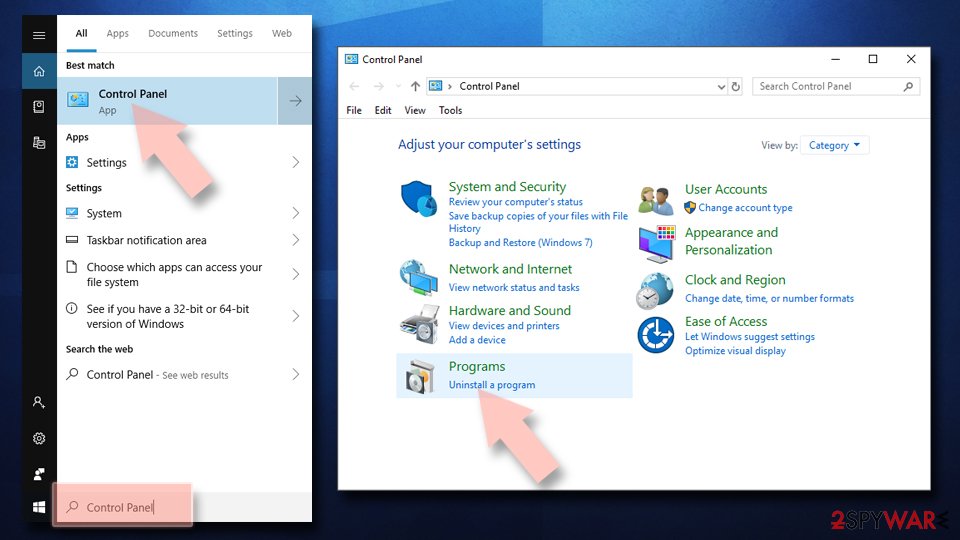
- From the list, find the entry of the suspicious program.
- Right-click on the application and select Uninstall.
- If User Account Control shows up, click Yes.
- Wait till uninstallation process is complete and click OK.
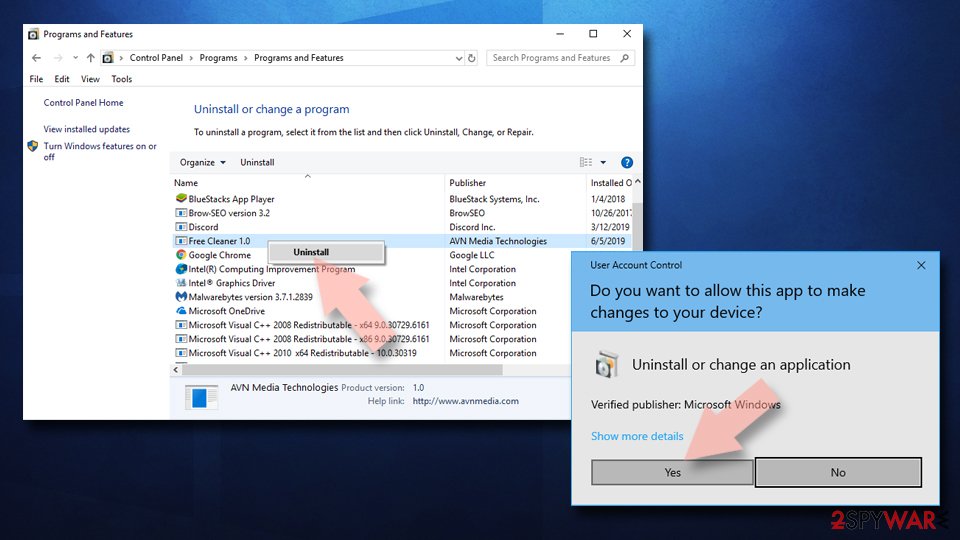
If you are Windows 7/XP user, proceed with the following instructions:
- Click on Windows Start > Control Panel located on the right pane (if you are Windows XP user, click on Add/Remove Programs).
- In Control Panel, select Programs > Uninstall a program.

- Pick the unwanted application by clicking on it once.
- At the top, click Uninstall/Change.
- In the confirmation prompt, pick Yes.
- Click OK once the removal process is finished.
Delete from macOS
Remove items from Applications folder:
- From the menu bar, select Go > Applications.
- In the Applications folder, look for all related entries.
- Click on the app and drag it to Trash (or right-click and pick Move to Trash)
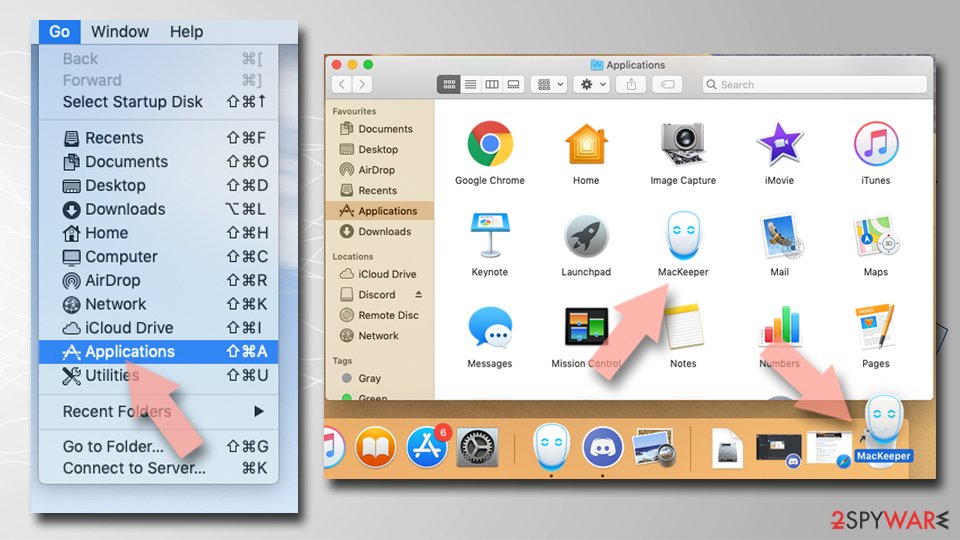
To fully remove an unwanted app, you need to access Application Support, LaunchAgents, and LaunchDaemons folders and delete relevant files:
- Select Go > Go to Folder.
- Enter /Library/Application Support and click Go or press Enter.
- In the Application Support folder, look for any dubious entries and then delete them.
- Now enter /Library/LaunchAgents and /Library/LaunchDaemons folders the same way and terminate all the related .plist files.

Remove from Microsoft Edge
Delete unwanted extensions from MS Edge:
- Select Menu (three horizontal dots at the top-right of the browser window) and pick Extensions.
- From the list, pick the extension and click on the Gear icon.
- Click on Uninstall at the bottom.
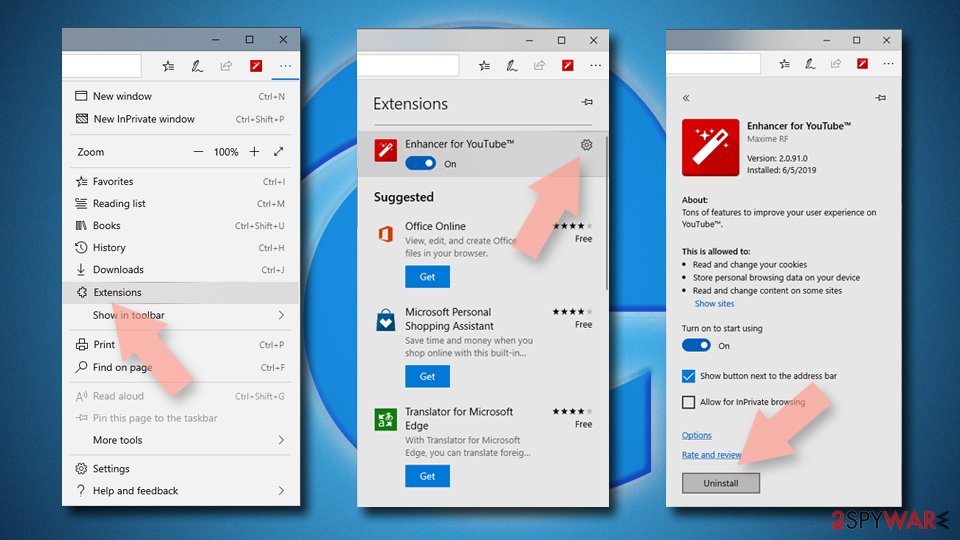
Clear cookies and other browser data:
- Click on the Menu (three horizontal dots at the top-right of the browser window) and select Privacy & security.
- Under Clear browsing data, pick Choose what to clear.
- Select everything (apart from passwords, although you might want to include Media licenses as well, if applicable) and click on Clear.
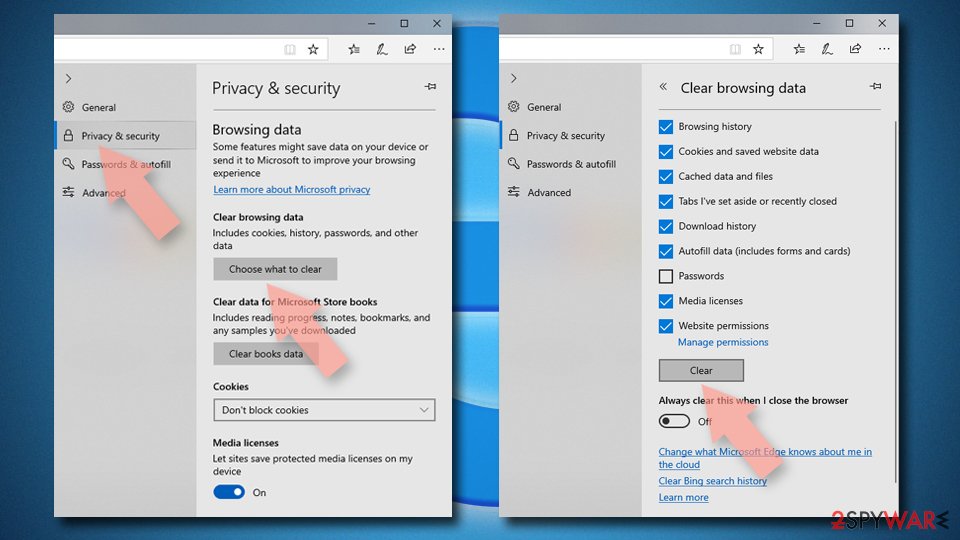
Restore new tab and homepage settings:
- Click the menu icon and choose Settings.
- Then find On startup section.
- Click Disable if you found any suspicious domain.
Reset MS Edge if the above steps did not work:
- Press on Ctrl + Shift + Esc to open Task Manager.
- Click on More details arrow at the bottom of the window.
- Select Details tab.
- Now scroll down and locate every entry with Microsoft Edge name in it. Right-click on each of them and select End Task to stop MS Edge from running.
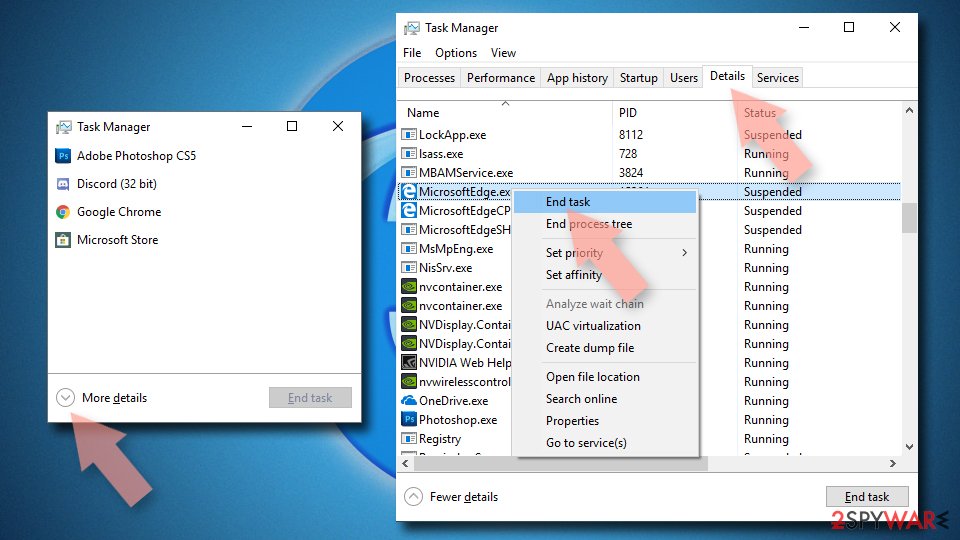
If this solution failed to help you, you need to use an advanced Edge reset method. Note that you need to backup your data before proceeding.
- Find the following folder on your computer: C:\\Users\\%username%\\AppData\\Local\\Packages\\Microsoft.MicrosoftEdge_8wekyb3d8bbwe.
- Press Ctrl + A on your keyboard to select all folders.
- Right-click on them and pick Delete
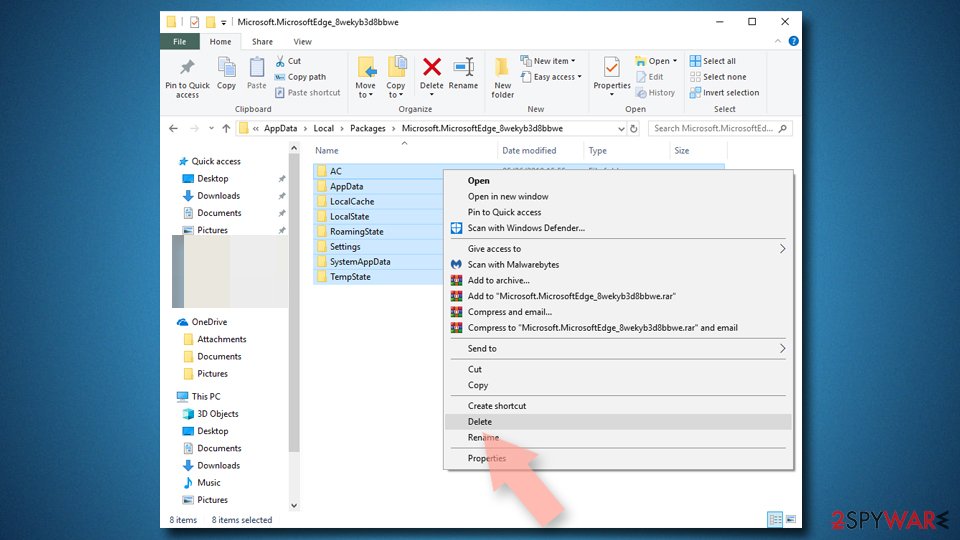
- Now right-click on the Start button and pick Windows PowerShell (Admin).
- When the new window opens, copy and paste the following command, and then press Enter:
Get-AppXPackage -AllUsers -Name Microsoft.MicrosoftEdge | Foreach {Add-AppxPackage -DisableDevelopmentMode -Register “$($_.InstallLocation)\\AppXManifest.xml” -Verbose
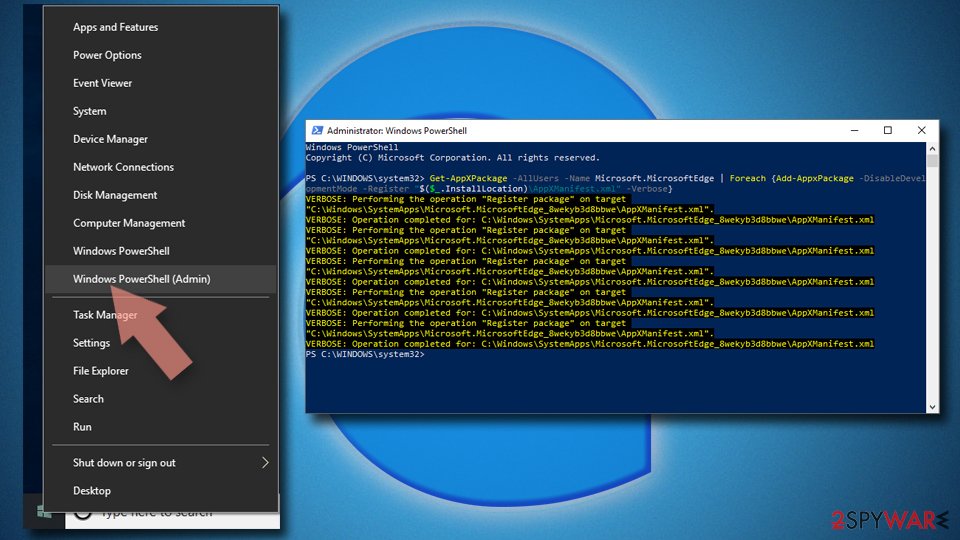
Instructions for Chromium-based Edge
Delete extensions from MS Edge (Chromium):
- Open Edge and click select Settings > Extensions.
- Delete unwanted extensions by clicking Remove.
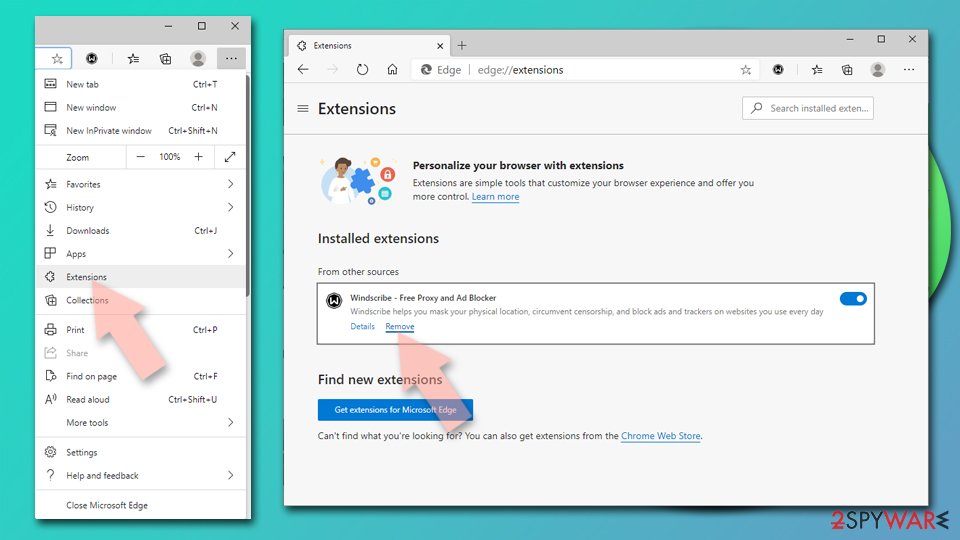
Clear cache and site data:
- Click on Menu and go to Settings.
- Select Privacy, search and services.
- Under Clear browsing data, pick Choose what to clear.
- Under Time range, pick All time.
- Select Clear now.
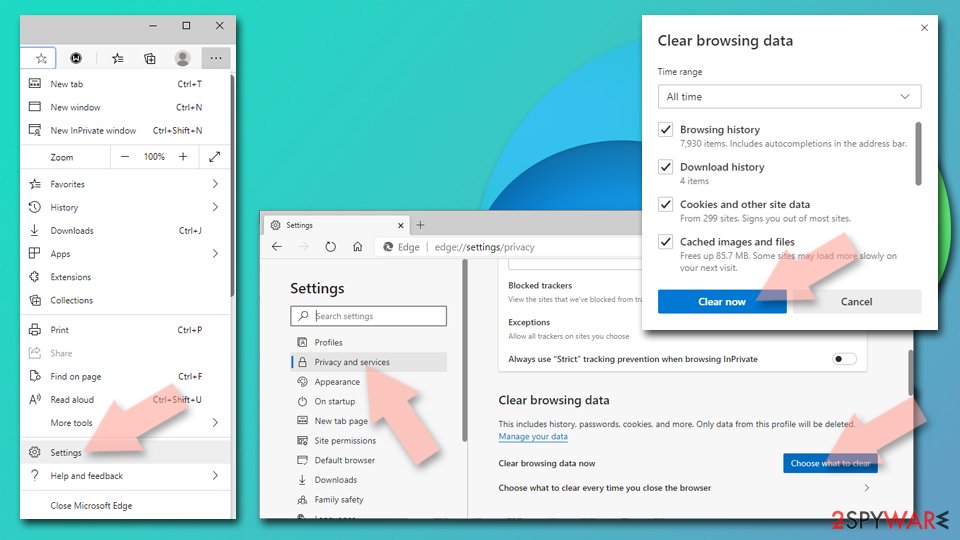
Reset Chromium-based MS Edge:
- Click on Menu and select Settings.
- On the left side, pick Reset settings.
- Select Restore settings to their default values.
- Confirm with Reset.
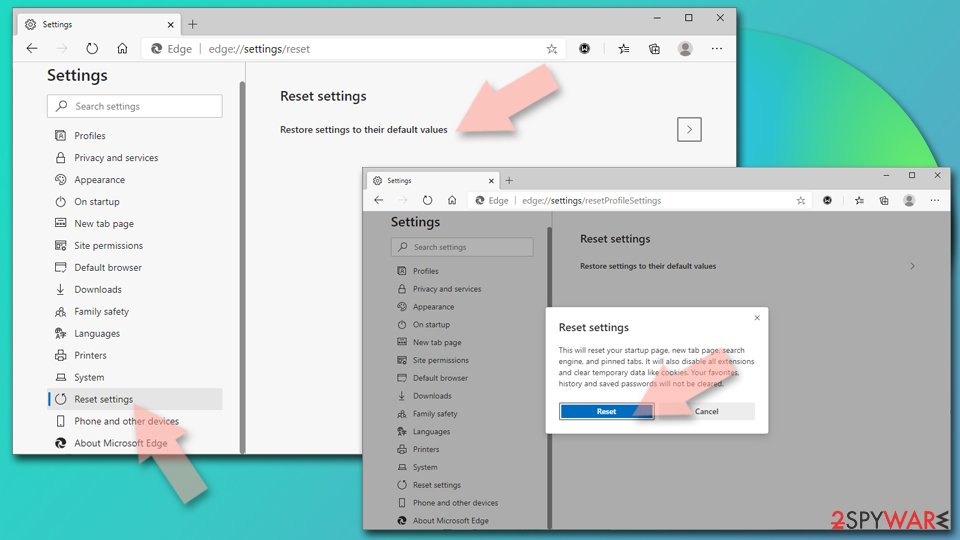
Remove from Mozilla Firefox (FF)
Remove dangerous extensions:
- Open Mozilla Firefox browser and click on the Menu (three horizontal lines at the top-right of the window).
- Select Add-ons.
- In here, select unwanted plugin and click Remove.
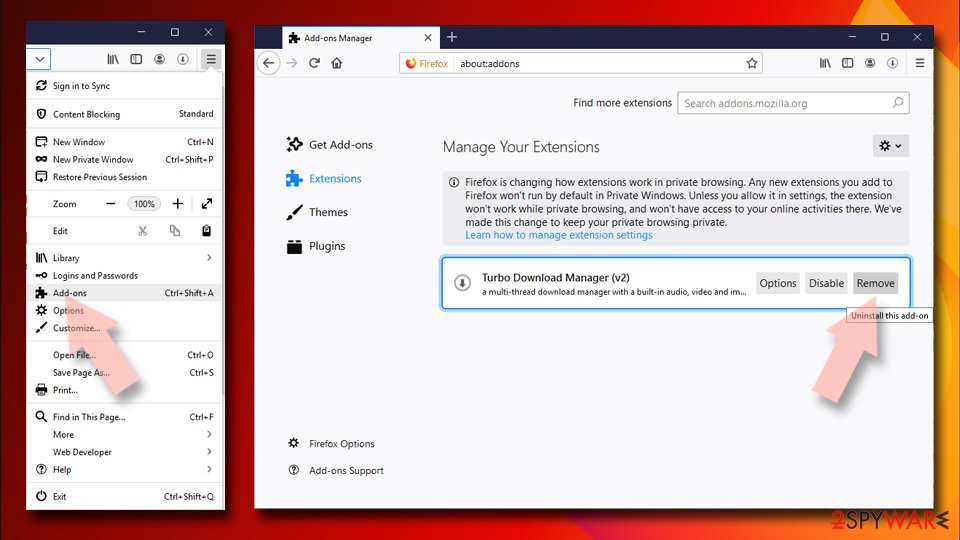
Reset the homepage:
- Click three horizontal lines at the top right corner to open the menu.
- Choose Options.
- Under Home options, enter your preferred site that will open every time you newly open the Mozilla Firefox.
Clear cookies and site data:
- Click Menu and pick Settings.
- Go to Privacy & Security section.
- Scroll down to locate Cookies and Site Data.
- Click on Clear Data…
- Select Cookies and Site Data, as well as Cached Web Content and press Clear.
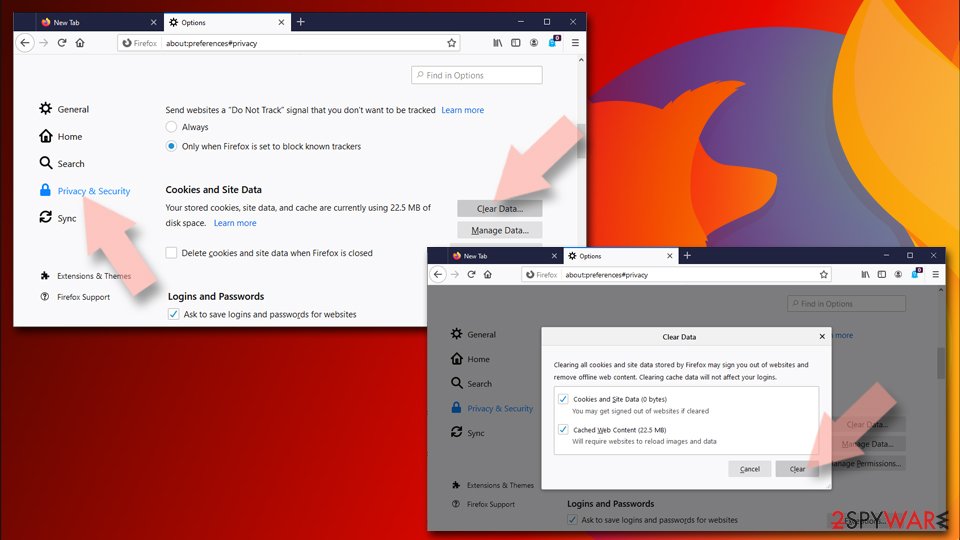
Reset Mozilla Firefox
If clearing the browser as explained above did not help, reset Mozilla Firefox:
- Open Mozilla Firefox browser and click the Menu.
- Go to Help and then choose Troubleshooting Information.
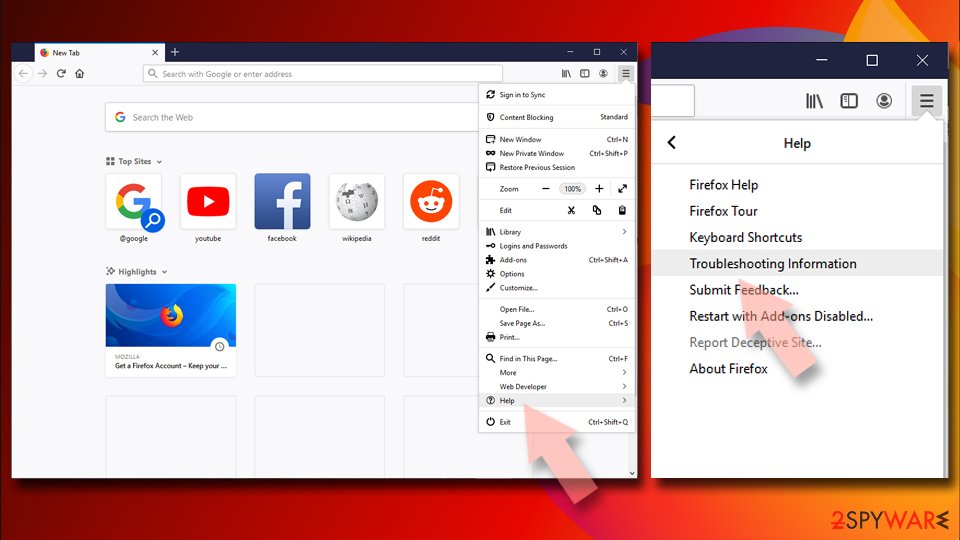
- Under Give Firefox a tune up section, click on Refresh Firefox…
- Once the pop-up shows up, confirm the action by pressing on Refresh Firefox.
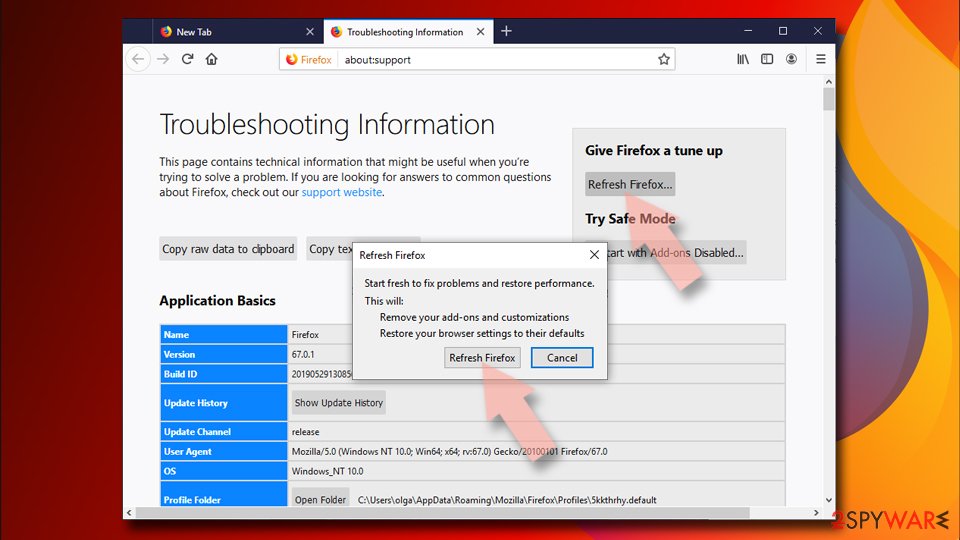
Delete from Safari
Remove unwanted extensions from Safari:
- Click Safari > Preferences…
- In the new window, pick Extensions.
- Select the unwanted extension and select Uninstall.
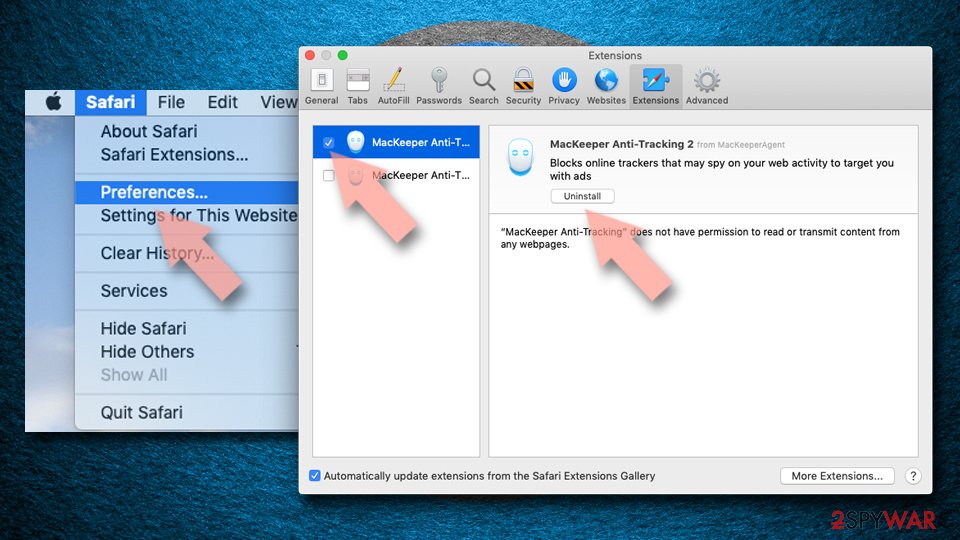
Clear cookies and other website data from Safari:
- Click Safari > Clear History…
- From the drop-down menu under Clear, pick all history.
- Confirm with Clear History.
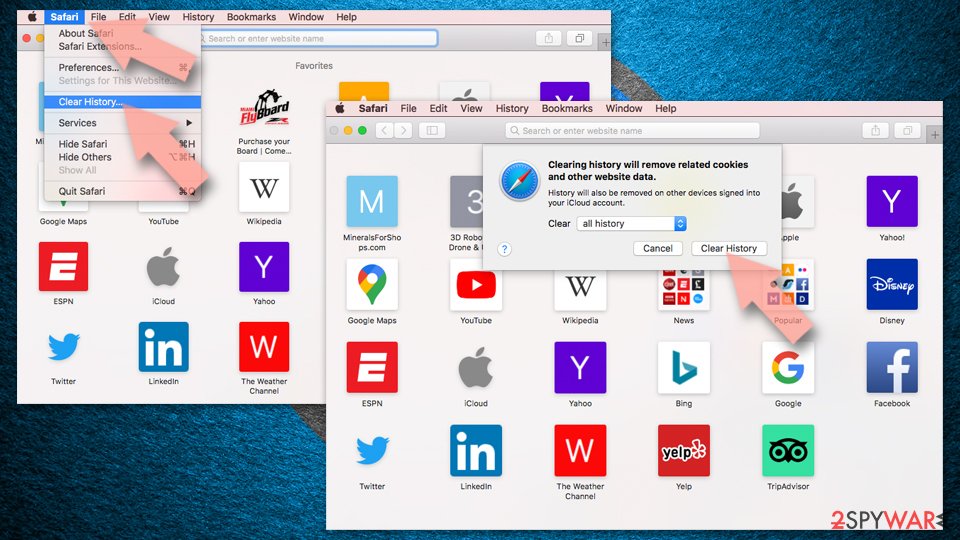
Reset Safari if the above-mentioned steps did not help you:
- Click Safari > Preferences…
- Go to Advanced tab.
- Tick the Show Develop menu in menu bar.
- From the menu bar, click Develop, and then select Empty Caches.
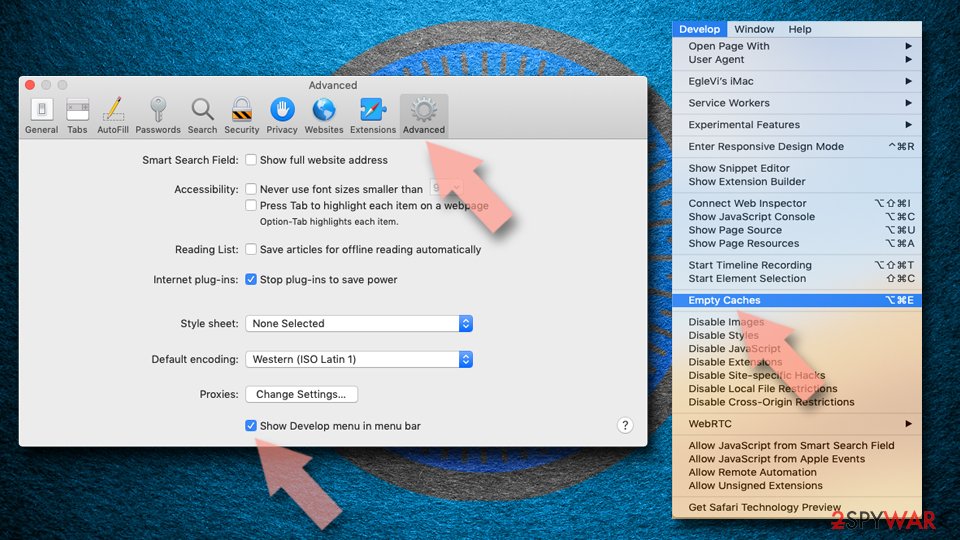
After uninstalling this potentially unwanted program (PUP) and fixing each of your web browsers, we recommend you to scan your PC system with a reputable anti-spyware. This will help you to get rid of Encrypted-Search browser hijacker registry traces and will also identify related parasites or possible malware infections on your computer. For that you can use our top-rated malware remover: FortectIntego, SpyHunter 5Combo Cleaner or Malwarebytes.
How to prevent from getting browser plugins
Choose a proper web browser and improve your safety with a VPN tool
Online spying has got momentum in recent years and people are getting more and more interested in how to protect their privacy online. One of the basic means to add a layer of security – choose the most private and secure web browser. Although web browsers can't grant full privacy protection and security, some of them are much better at sandboxing, HTTPS upgrading, active content blocking, tracking blocking, phishing protection, and similar privacy-oriented features. However, if you want true anonymity, we suggest you employ a powerful Private Internet Access VPN – it can encrypt all the traffic that comes and goes out of your computer, preventing tracking completely.
Lost your files? Use data recovery software
While some files located on any computer are replaceable or useless, others can be extremely valuable. Family photos, work documents, school projects – these are types of files that we don't want to lose. Unfortunately, there are many ways how unexpected data loss can occur: power cuts, Blue Screen of Death errors, hardware failures, crypto-malware attack, or even accidental deletion.
To ensure that all the files remain intact, you should prepare regular data backups. You can choose cloud-based or physical copies you could restore from later in case of a disaster. If your backups were lost as well or you never bothered to prepare any, Data Recovery Pro can be your only hope to retrieve your invaluable files.
- ^ Understanding & Stopping Malicious Redirects. securityboulevard. IT and security reports.
- ^ Windows DLL issues. Reimageplus. Windows errors.
- ^ Novirus. Novirus. Spyware related news.
